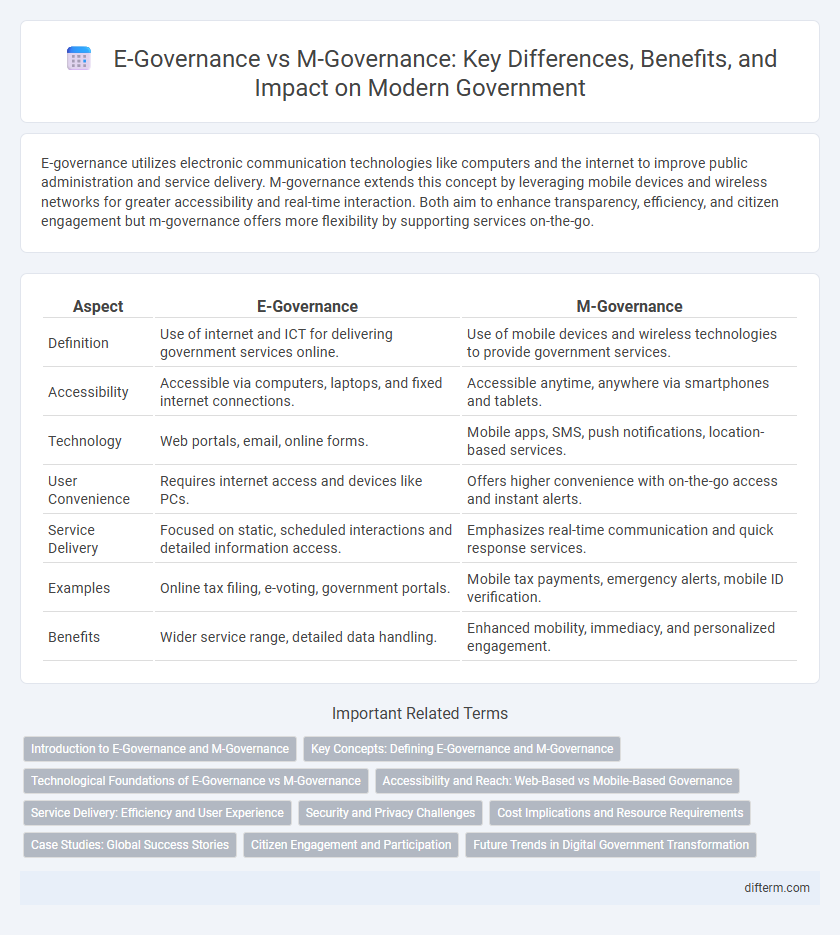E-governance utilizes electronic communication technologies like computers and the internet to improve public administration and service delivery. M-governance extends this concept by leveraging mobile devices and wireless networks for greater accessibility and real-time interaction. Both aim to enhance transparency, efficiency, and citizen engagement but m-governance offers more flexibility by supporting services on-the-go.
Table of Comparison
| Aspect | E-Governance | M-Governance |
|---|---|---|
| Definition | Use of internet and ICT for delivering government services online. | Use of mobile devices and wireless technologies to provide government services. |
| Accessibility | Accessible via computers, laptops, and fixed internet connections. | Accessible anytime, anywhere via smartphones and tablets. |
| Technology | Web portals, email, online forms. | Mobile apps, SMS, push notifications, location-based services. |
| User Convenience | Requires internet access and devices like PCs. | Offers higher convenience with on-the-go access and instant alerts. |
| Service Delivery | Focused on static, scheduled interactions and detailed information access. | Emphasizes real-time communication and quick response services. |
| Examples | Online tax filing, e-voting, government portals. | Mobile tax payments, emergency alerts, mobile ID verification. |
| Benefits | Wider service range, detailed data handling. | Enhanced mobility, immediacy, and personalized engagement. |
Introduction to E-Governance and M-Governance
E-Governance refers to the use of information and communication technologies (ICT) to deliver government services, enhance administrative efficiency, and promote transparency and citizen engagement through online platforms. M-Governance, a subset of e-governance, leverages mobile technologies and devices to provide government services, ensuring accessibility and real-time interaction for citizens anywhere and anytime. Both models aim to streamline public administration, but m-governance addresses the increasing reliance on smartphones and mobile internet for government-citizen communication.
Key Concepts: Defining E-Governance and M-Governance
E-Governance refers to the use of information and communication technologies (ICT) by government bodies to deliver services, enhance transparency, and improve administrative efficiency through online platforms and portals. M-Governance, a subset of e-governance, specifically utilizes mobile technologies such as smartphones and tablets to provide government services, ensuring accessibility anytime and anywhere. Both concepts aim to facilitate citizen engagement, streamline processes, and promote digital inclusion, with e-governance encompassing a broader ICT scope while m-governance focuses on mobility and real-time interaction.
Technological Foundations of E-Governance vs M-Governance
E-governance relies on fixed internet infrastructure, desktop computers, and web-based applications to deliver public services, emphasizing stable high-bandwidth connectivity and traditional ICT frameworks. M-governance leverages mobile networks, smartphones, and wireless communication technologies like 4G/5G to enable ubiquitous access, real-time interactions, and location-based services. The technological foundation of m-governance prioritizes mobility, portability, and instant communication, contrasting with the stationary, broadband-dependent infrastructure of e-governance.
Accessibility and Reach: Web-Based vs Mobile-Based Governance
E-governance leverages web-based platforms, offering comprehensive access via computers and laptops, making it suitable for detailed administrative tasks but limited by internet availability and device accessibility. M-governance capitalizes on mobile technology, enabling broader reach through smartphones, which are more prevalent across diverse demographic segments, enhancing real-time access to government services. Mobile-based governance improves accessibility in remote and underserved areas by utilizing cellular networks, overcoming the infrastructural constraints of traditional web access.
Service Delivery: Efficiency and User Experience
E-governance platforms streamline service delivery through centralized online portals, enhancing efficiency by reducing paperwork and processing times for citizens accessing government services. M-governance leverages mobile technology to provide real-time access, location-based services, and personalized notifications, significantly improving user experience and inclusivity for users in remote or underserved areas. The integration of mobile applications with cloud computing and AI-driven chatbots further optimizes responsiveness and user engagement in public administration.
Security and Privacy Challenges
E-governance and m-governance present distinct security and privacy challenges, with e-governance relying on fixed infrastructure that is susceptible to centralized cyberattacks and data breaches. M-governance, leveraging mobile platforms, introduces vulnerabilities through device mobility, unsecured wireless networks, and inconsistent encryption standards, increasing risks of unauthorized access and data interception. Ensuring robust encryption protocols, multi-factor authentication, and stringent data protection policies is crucial to safeguarding citizen information in both governance models.
Cost Implications and Resource Requirements
E-governance typically demands substantial upfront investment in infrastructure, including servers, broadband networks, and data centers, whereas m-governance leverages existing mobile networks, reducing initial costs but requiring ongoing expenses for mobile app development and data security. Resource allocation for e-governance often involves extensive IT personnel and training focused on web platforms, while m-governance necessitates specialized skills in mobile technology, user experience design, and continuous software updates. Financial planning must account for these differences, as e-governance tends toward higher capital expenditure and m-governance incurs greater operational costs over time.
Case Studies: Global Success Stories
E-governance initiatives in Estonia demonstrate how integrated digital platforms streamline public services, enhancing transparency and citizen engagement. India's m-governance project, mKisan, leverages mobile technology to deliver agricultural information directly to farmers, improving productivity and livelihood. South Korea's innovative use of mobile applications for e-governance access highlights the role of widespread smartphone adoption in expanding digital government reach.
Citizen Engagement and Participation
E-governance leverages digital platforms such as government websites and online portals to enhance citizen engagement by providing accessible information and services. M-governance utilizes mobile technology to foster real-time participation, enabling citizens to interact with government services anytime and anywhere through smartphones and apps. This mobile-centric approach increases inclusivity and responsiveness, particularly benefiting remote and underserved populations.
Future Trends in Digital Government Transformation
E-governance leverages internet-based platforms to enhance administrative efficiency, while m-governance utilizes mobile technologies to increase accessibility and real-time citizen engagement. Future trends in digital government transformation emphasize AI integration, blockchain for secure transactions, and 5G connectivity to enable seamless mobile services. Governments worldwide prioritize interoperability and data-driven decision-making to create inclusive, responsive, and transparent digital public services.
e-governance vs m-governance Infographic

 difterm.com
difterm.com